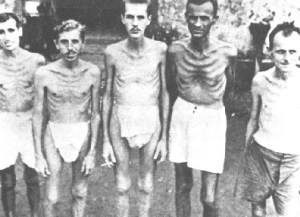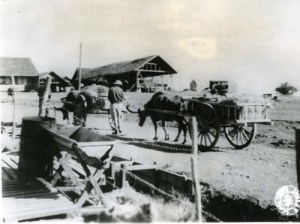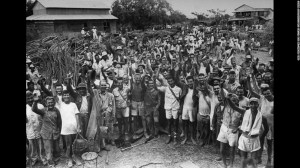Today, Cabanatuan calls itself the “Tricycle Capital of the Philippines”, with about 30,000 motorized “auto rickshaws”. 72 years ago, it was home to one of the worst POW camps of WWII.
 1942 was a bad year for the allied war in the Pacific. The Battle of Bataan alone resulted in 72,000 prisoners being taken by the Japanese, marched off to POW camps designed for 10,000 to 25,000.
1942 was a bad year for the allied war in the Pacific. The Battle of Bataan alone resulted in 72,000 prisoners being taken by the Japanese, marched off to POW camps designed for 10,000 to 25,000.
20,000 of them died from sickness or hunger, or were murdered by Japanese guards on the 60 mile “death march” from Bataan, into captivity at Cabanatuan prison and others.
Cabanatuan held 8,000 prisoners at its peak, though the number dropped considerably as the able-bodied were shipped out to work in Japanese slave labor camps.
Two rice rations per day, fewer than 800 calories, were supplemented by the occasional animal or insect caught and killed inside camp walls, or by the rare food items smuggled in by civilian visitors. 2,400 died in the first eight months at Cabanatuan, animated skeletons brought to “hospital wards”, which were nothing more than 2’x6′ patches of floor where prisoners waited to die. A Master Sergeant Gaston saw one of these wards in July 1942, saying: “The men in the ward were practically nothing but skin and bones and they had open ulcers on their hips, on their knees and on their shoulders…maggots were eating on the open wounds. There were blow flies…by the millions…men were unable to get off the floor to go to the latrine and their bowels moved as they lay there”.

The war was going badly for the Japanese by October 1944, as Imperial Japanese High Command ordered able bodied POWs removed to Japan. 1,600 were taken from Cabanatuan, leaving 500 weak and disabled prisoners. The guards abandoned camp shortly after, though Japanese soldiers continued to pass through. POWs were able to steal food from abandoned Japanese quarters; some even captured two water buffalo called “Carabao”, which were killed and eaten. Many feared a trick and never dared to leave the camp. Most were too sick and weak to leave in any case, though the extra rations would help them through what was to come.
On December 14, units of the Japanese Fourteenth Area Army in Palawan doused 150 prisoners with gasoline and burned them alive, machine gunning any who tried to escape the flames. The atrocity sparked a series of raids at Santo Tomas Internment Camp, Bilibid Prison, Los Baños and others. The first such behind-enemy-lines rescue, was Cabanatuan.

On the evening of January 27, 1945, 14 individuals separated into two teams, beginning the 30 mile march behind enemy lines to liberate Cabanatuan. They were an advance team, formed from the 6th Ranger Battalion and a special reconnaissance group called the Alamo Scouts. The main force of 121 Rangers moved out the following day, meeting up with 200 Filipino guerrillas, who served as guides and helped in the rescue.
Other guerrillas assisted along the way, muzzling dogs and corralling chickens so that Japanese occupiers would hear nothing of their approach. Japanese soldiers once again occupied the camp, with 1,000 more camped across the Cabo River outside the prison and as many as 7,000 deployed just a few miles away.

On the night of the 30th, a P-61 Black Widow piloted by Captain Kenneth Schrieber and 1st Lt. Bonnie Rucks staged a ruse. For 45 minutes, the pair conducted a series of aerial acrobatics, cutting and restarting engines with loud backfires while seeming to struggle to maintain altitude. Thousands of Japanese soldiers watched the show, as Rangers belly crawled into positions around the camp.
Guard towers and pillboxes were wiped out in the first fifteen seconds of the assault. Filipino guerrillas blew the bridge and ambushed the large force across the river while one, trained to use a bazooka only hours earlier, took out four Japanese tanks.
In the camp, all was pandemonium as some prisoners came out and others hid, suspecting some trick to bring them out into the open. They were so emaciated that Rangers carried them out two at a time.
The raid was over in 35 minutes, POWs brought to pre-arranged meet-up places with dozens of carabao carts. A long trek yet remained, one POW said “I made the Death March from Bataan, so I can certainly make this one!” Over three days, up to 106 carts joined the procession, their plodding 2 MPH progress covered by strafing American aircraft.
Two American Rangers and two prisoners were killed, another 4 Americans and 21 Filipinos wounded, compared with 500-1,000 Japanese killed and four tanks put out of action. 464 American military personnel were liberated, along with 22 British and 3 Dutch soldiers, 28 American civilians, 2 Norwegians and one civilian each of British, Canadian and Filipino nationalities.

One POW was left behind, a British soldier named Edwin Rose. Rose heard the firing and thought the Americans were there to stay, so he went back to sleep. When he woke the next morning and realized he had “Cabanatuan all my own”, he shaved, put on his best clothes, and walked out of camp. Passing guerrillas found him and passed him to a tank destroyer. Give the man points for style. A few days later, Rose strolled into 6th army headquarters, a cane tucked under his arm.
The Cabanatuan raid of January 30, 1945 liberated over 500 allied prisoners, from virtually every state in the Union. Begging pardon for any mistakes in rank and/or spelling, the following represents those from my home state of Massachusetts:
- Lieutenant Commander Robert Strong, Jr., Arlington
- Captain John Dugan, Milton
- 2nd Lieutenant John Temple, Pittsfield
- Sergeant Richard Neault, Adams
- Sergeant Stanislaus Malor, Salem
- Private, 1st Class Joseph Thibeault, Lawrence
- Private Edward Searkey, Lynn
- USN C/QM Martin Seliga, Fitchburg
- USN 1/C PO J.E.A. Morin,Danvers
- USN AC MM Carl Silverman, Wareham
I hope I didn’t leave anyone out. These guys have earned the right to be remembered.




 Joining the 3rd Infantry Division of George S. Patton’s 7th Army, Murphy participated in amphibious landings in Sicily in July, fighting in nearly every aspect of the Italian campaign. From Palermo to Messina and on to Naples, Anzio and Rome, the Germans were driven out of the Italian peninsula in savage and near continuous fighting that killed a member of my own family. By mid-December, the 3rd ID suffered 683 dead, 170 missing, and 2,412 wounded. Now Sergeant Murphy was there for most of it, excepting two periods when he was down with malaria.
Joining the 3rd Infantry Division of George S. Patton’s 7th Army, Murphy participated in amphibious landings in Sicily in July, fighting in nearly every aspect of the Italian campaign. From Palermo to Messina and on to Naples, Anzio and Rome, the Germans were driven out of the Italian peninsula in savage and near continuous fighting that killed a member of my own family. By mid-December, the 3rd ID suffered 683 dead, 170 missing, and 2,412 wounded. Now Sergeant Murphy was there for most of it, excepting two periods when he was down with malaria. “Colmar Pocket” was an 850 square mile area held by German troops: Murphy described it as “a huge and dangerous bridgehead thrusting west of the Rhine like an iron fist. Fed with men and materiel from across the river, it is a constant threat to our right flank; and potentially it is a perfect springboard from which the enemy could start a powerful counterattack.”
“Colmar Pocket” was an 850 square mile area held by German troops: Murphy described it as “a huge and dangerous bridgehead thrusting west of the Rhine like an iron fist. Fed with men and materiel from across the river, it is a constant threat to our right flank; and potentially it is a perfect springboard from which the enemy could start a powerful counterattack.” Let Murphy’s Medal of Honor Citation describe what happened next: “Second Lieutenant Audie L. Murphy, 01692509, 15th Infantry, Army of the United States, on 26 January 1945, near Holtzwihr, France, commanded Company B, which was attacked by six tanks and waves of infantry. Lieutenant Murphy ordered his men to withdraw to a prepared position in a woods while he remained forward at his command post and continued to give fire directions to the artillery by telephone. Behind him to his right one of our tank destroyers received a direct hit and began to burn. Its crew withdrew to the woods. Lieutenant Murphy continued to direct artillery fire which killed large numbers of the advancing enemy infantry. With the enemy tanks abreast of his position, Lieutenant Murphy climbed on the burning tank destroyer which was in danger of blowing up any instant and employed its .50 caliber machine gun against the enemy. He was alone and exposed to the German fire from three sides, but his deadly fire killed dozens of Germans and caused their infantry attack to waver. The enemy tanks, losing infantry support, began to fall back. For an hour the Germans tried every available weapon to eliminate Lieutenant Murphy, but he continued to hold his position and wiped out a squad which was trying to creep up unnoticed on his right flank. Germans reached as close as 10 yards only to be mowed down by his fire. He received a leg wound but ignored it and continued the single-handed fight until his ammunition was exhausted. He then made his way to his company, refused medical attention, and organized the company in a counterattack which forced the Germans to withdraw. His directing of artillery fire wiped out many of the enemy; he personally killed or wounded about 50. Lieutenant Murphy’s indomitable courage and his refusal to give an inch of ground saved his company from possible encirclement and destruction and enabled it to hold the woods which had been the enemy’s objective”.
Let Murphy’s Medal of Honor Citation describe what happened next: “Second Lieutenant Audie L. Murphy, 01692509, 15th Infantry, Army of the United States, on 26 January 1945, near Holtzwihr, France, commanded Company B, which was attacked by six tanks and waves of infantry. Lieutenant Murphy ordered his men to withdraw to a prepared position in a woods while he remained forward at his command post and continued to give fire directions to the artillery by telephone. Behind him to his right one of our tank destroyers received a direct hit and began to burn. Its crew withdrew to the woods. Lieutenant Murphy continued to direct artillery fire which killed large numbers of the advancing enemy infantry. With the enemy tanks abreast of his position, Lieutenant Murphy climbed on the burning tank destroyer which was in danger of blowing up any instant and employed its .50 caliber machine gun against the enemy. He was alone and exposed to the German fire from three sides, but his deadly fire killed dozens of Germans and caused their infantry attack to waver. The enemy tanks, losing infantry support, began to fall back. For an hour the Germans tried every available weapon to eliminate Lieutenant Murphy, but he continued to hold his position and wiped out a squad which was trying to creep up unnoticed on his right flank. Germans reached as close as 10 yards only to be mowed down by his fire. He received a leg wound but ignored it and continued the single-handed fight until his ammunition was exhausted. He then made his way to his company, refused medical attention, and organized the company in a counterattack which forced the Germans to withdraw. His directing of artillery fire wiped out many of the enemy; he personally killed or wounded about 50. Lieutenant Murphy’s indomitable courage and his refusal to give an inch of ground saved his company from possible encirclement and destruction and enabled it to hold the woods which had been the enemy’s objective”. Hollywood and, until his death in a plane crash in 1971, his post-war life was never free of it.
Hollywood and, until his death in a plane crash in 1971, his post-war life was never free of it.
You must be logged in to post a comment.